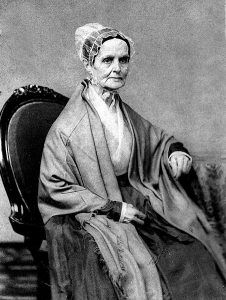Image credited to Wikimedia Commons
By Kyra Charles
There is a reserved canon of influential women who were considered pioneers of the Women’s Suffrage movement. Through the years, the Women’s Center has written about Susan B. Anthony, Elizabeth Cady Stanton, Ida B. Wells and Sojourner Truth. But today, I want to write about Lucretia Mott, one of the famous suffragists who will be appearing on the back of $10 bill this August. Throughout her life, Lucretia fought tooth and nail not only for women’s suffrage, but for social reforms like the right to divorce and African Americans’ right to vote. Without Lucretia, many of the famous suffragists we know wouldn’t have made the strides they did.
Lucretia Mott, born Lucretia Coffin in 1793, was raised as a Quaker. Her religious education and upbringing taught her that all people were equal under God, including those that were living in slavery. She founded the Philadelphia Female Anti-Slavery Society in 1833, and hosted the second Anti-Slavery Convention of American Women in 1838. Throughout this time at her life, she was under constant threat from abolition opponents and even other abolitionists who didn’t want women at their meetings. Angry mobs targeted her events and gathered outside her home. Lucretia was unfazed, and at the 1838 convention, assigned every white women to walk arm and arm with a black women for safety.
Her efforts paid off, as she was invited to the White House to speak in front of Congress and met with President John Tyler. Lucretia was also one of the six women who spoke at the World’s Anti-Slavery Convention, and gained the title of “Lioness of the Convention” for her speech. She dazzled the crowd, including a twenty-four year old Elizabeth Cady Stanton, who Lucretia would take under her wing.
Together, they organized the famous Seneca Falls Convention, where many of the brightest minds fighting against social injustice gathered to discuss women’s rights. She signed the Declaration of Sentiments, which not only demanded a woman’s right to vote, but to education, divorce, property, and career. Following the Civil war, she became the first president of the American Equal Rights Association. But when her former pupil Elizabeth Cady Stanton joined with a known racist businessman, Lucretia resigned. For years, she tried to heal the divide between the white female suffragists and African Americans, truly believing equality didn’t stop with a white woman’s right to vote.
From appearances alone, Lucretia Mott doesn’t give the impression of a “Lioness” but that is exactly what she was. For decades she fearlessly advocated for equal rights and the end to slavery, even in the face of violence and unpopularity. She was able to take her voice where few women had gone before, and keep going after that. Lucretia was able to lead a life that many women after her hoped to live, one where she practiced what she preached with determination and kindness.